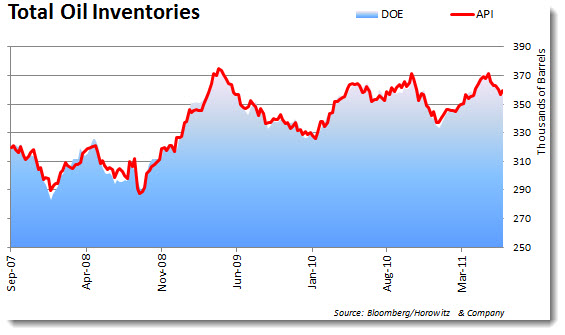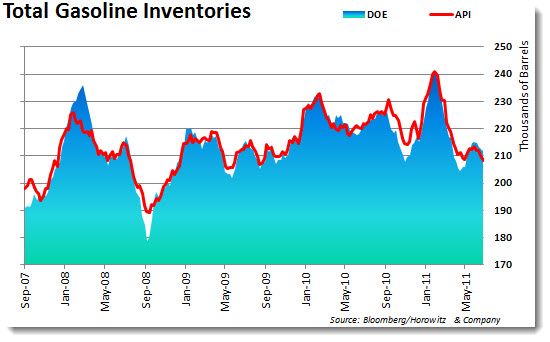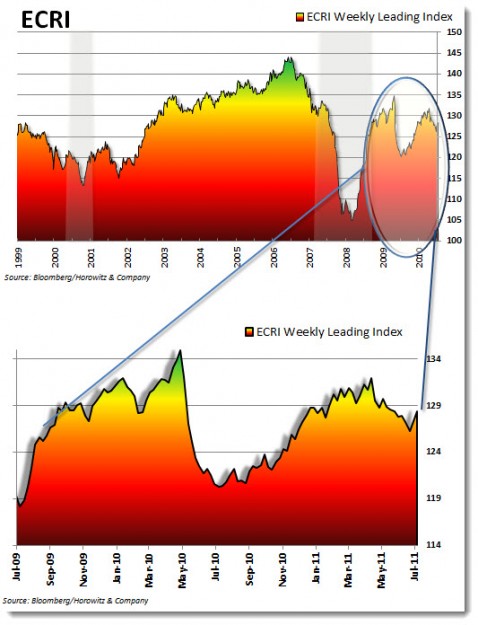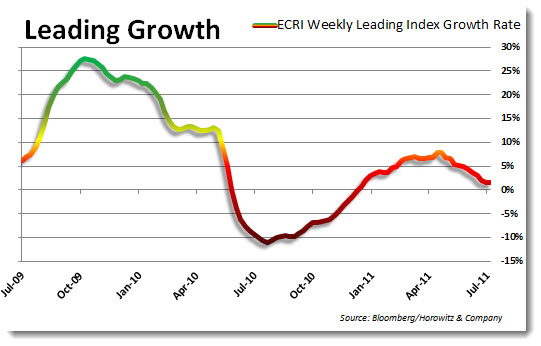A few of the headlines today from IBD. Nothing to get too excited about…
Goldman Sachs says the economy grew at a 1.5% annual rate in Q2, down from its previous forecast of 2%, due to disappointing consumer spending data. It also slashed its Q3 growth forecast to a 2.5% annual rate from 3.25%. The economy grew at a 1.9% rate in Q1. The gov‘t releases Q2 GDP figures July 29.
Ratings agency Moody‘s hinted that the U.S. should scrap its statutory limit on gov‘t borrowing to ease concerns about the govt‘s ability to meet its obligations. The U.S. is among the few countries that has a Congress-imposed debt ceiling. Moody‘s has said it may cut the U.S.‘s AAA credit rating if the gov‘t misses payments.
BuildFax‘s residential remodeling index rose 13% in May as homeowners sought to upgrade current homes rather than buy a new one. The index was up 22% vs. a year ago, the 19th straight gain, to a record high.
Economists in a Reuters poll trimmed their ‘11 and ‘12 growth forecasts for China, India and other countries in the region as the global economy throttles back. The slowdown should be moderate, with Chinese growth staying well above 8%. But inflation pressures and debt woes in Europe and the U.S. pose risks to the outlook.
Chinese home prices rose an average of 4.2% in June from a year earlier, edging up from May‘s 4.1% rise, according to a Reuters estimate based on official data. Many economists warn of a brewing housing bubble that could threaten the world‘s No.2 economy.
U.K. aims to sell bank stakes U.K. Financial Investments, which manages gov‘t stakes in bailed-out banks, said it would increasingly focus on selling off the assets despite regulatory changes that could erode their value. The gov‘t has reportedly said it plans to start disposing of its stakes early next year.
Brazil inflation view steady Inflation is expected to rise 6.31% this year and 5.2% next year, unchanged from week-earlier forecasts, according to a central bank survey of economists. They also stuck to their view that the central bank will hike interest rates by 50 basis points by year-end to 12.75% to curb price pressures. Brazilian policymakers meet this week.
___
Looking to invest in The Disciplined Investor Managed Growth Strategy?
Click HERE for the virtual tour….
___
Good news! New housing starts exceeded expectations in June, rising from 549,000 in May to 629,000 in June, according to Briefing.com. The Briefing.com consensus expected housing starts to increase to 570,000.
That is the highest number of new housing starts since January when a surge in volatile multifamily construction inflated the totals. This time, however, growth was equally weighted between the relatively more stable single-family and multi-family sectors.
Normally, solid growth in the single-family sector would provide evidence that the monthly increase in starts was not the result of a one-time surge. However, builders and contractors noted in previous construction reports that poor weather in April and May delayed some construction projects until June. This could explain the notable jump in June starts.
Even though the growth in starts may be due to special factors, it is important to note that the number of homes currently under construction increased from 415,000 in May to 419,000 in June. While the growth may look modest, it is the first time since May 2006 that the number of homes under construction increased on a monthly basis.
It is still too early to call a bottom in the housing construction sector, but continued expansion in the number of units under construction would support the notion. This suggests that builders not only want to increase their inventory levels, but it also shows that they believe demand for new homes will rebound in the latter half of the year.
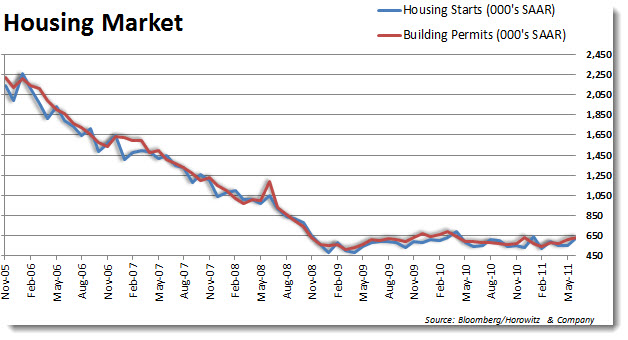
Earnings this morning provided a nice opportunity to squeeze shorts once again. With economic news coming in slightly better than expected (although still very depressed from historical levels) the futures were rallying into the open. The red that that was splattered all over the stock monitors yesterday were nice and green today (so far). There were some reversals as well as profit taking is still part of the market environment.
As an example, while Wynn smashed views, shares came off an earlier 3% surge toward the flat line. Goldman Sachs was down as much as 4% as they reported one of the worst quarters in years. The stock then rallied toward the unchanged mark as they announced in the conference call $1.2 billion of expense cuts. Bank of America put up their worst loss in the company’s history.
Oil was moving higher into the Tuesday night inventory number from the API and the Wednesday DOE levels. There is a bullish bias toward commodities of late. Even with obvious signs that there is a slowdown in global economies.
But, commodity traders don’t really care too much about the fundamental backdrop. Rather they are all about the squeeze and the squash. When prices are rising, there is a penguin-like charge toward a buy-ticket. When falling, there is a quick panic until the final group of buy-the-dip appears again. Simply momentum trading on its most basic level as there are no earnings or revenue reports, simply supply and demand on a short-term basis.
From the National Post, via Bloomberg:
Oil rose on Tuesday lifted by expectations that data would show crude inventories in the world’s top consumer fell for a seventh week and supported by dollar weakness.
Further support came from a strong start on Wall Street due to upbeat corporate earnings and data showing that U.S. housing starts hit a six-month high in June By 1401 GMT, Brent crude futures were up $1.87 at $117.92. U.S. crude added $2.30 to $98.23. An expected fall in U.S. stocks of oil is seen as keeping upward pressure on crude prices.
Inventories are likely to have fallen by 1.3 million barrels last week due to higher refinery utilization and a slide in imports, a Reuters poll showed ahead of weekly reports. “Estimates that there’s been a drawdown in gasoline are giving prices a bit of a boost, but we are really range trading after the weakness we saw the previous session,” said Tony Machacek, futures broker at Jefferies Bache.
In the second-largest oil consumer China, refined oil product stocks at the end of June increased nearly 1 million tonnes from a year earlier. They were at a normal level, after fuel consumption slowed down since mid-April, a government report showed on Tuesday. The dollar softened versus the euro EUR and a basket of currencies on Tuesday as the single currency regained some ground after losses in the previous session on worries that the euro zone debt crisis will worsen.A weaker dollar makes oil and other commodities more affordable for holders of other currencies. Debt problems on both sides of the Atlantic saw investors move into safer assets and helped gold to reach another record high.
Analysts said that oil was also a beneficiary of thereluctance to hold financial assets. “There’s a desire to hold something that has a physical reality as opposed to bonds and shares, that has the ability to keep its values when everything else falls,” Christophe Barret, oil analyst at Credit Agricole Corporate and Investment Bank.
Highlighting the fragile state of the euro zone’s economy and keeping investors wary of holding riskier assets, German analyst and investor sentiment fell more than expected in July to its lowest level since January 2009.
Figures from the Mannheim-based ZEW economic think tank showed its economic sentiment index fell to -15.1 from -9.0 in June, below the consensus forecast in a Reuters poll for a decrease to -12.4.
Oil was also supported by expectations that the International Energy Agency (IEA) would not release emergency stocks for a second time. This was because there was no sign yet of the kind of shortage to mandate another dip into the West’s emergency oil reserves when a 30-day deadline for assessing the impact of a first release expires at the end of this week, traders and analysts said.
For another IEA release to take place, it would have to be endorsed by all 28 members of the energy consumer body. Germany and Italy are likely to resist any plans for a second release for now, a French government source told Reuters last week. Oil has remained in a fairly tight range through July, but some price chart analysts see scope for upside potential with strong support near current levels.
“We would need to see a close below $115.39 for Brent, the 100 day moving average for further weakness, if this happens it could move down to the $113 area,” said Lynnden Branigan, technical analyst at Barclays Capital. “However the risk is to the upside, with resistance around the $118.90 area that we saw it peaking at last week.”
Gas prices continue to rise, faster than prices for oil. This week, the average gas price in Alaska topped $4 per gallon and the U.S. average moved above the 1-month MA.
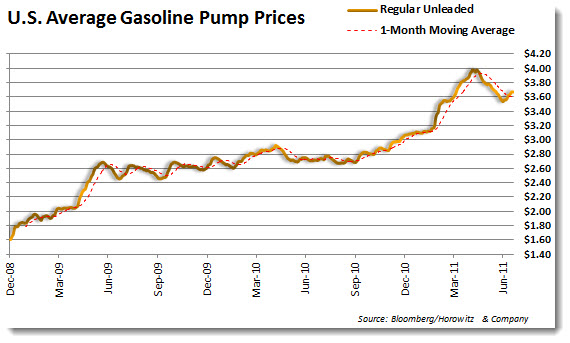
Finally, on the economic front, the ECRI Weekly Leading Index popped a bit higher this week. A good sign that there there may be stabilization.
On the other hand, the ECRI leading Growth Index continues to be in a downtrend. While it may seem as though there is a contradiction with the two, that is perfectly normal. The Growth index provides a smoother look at the trend and the Leading Index is better to look at as a reference of the current situation.


